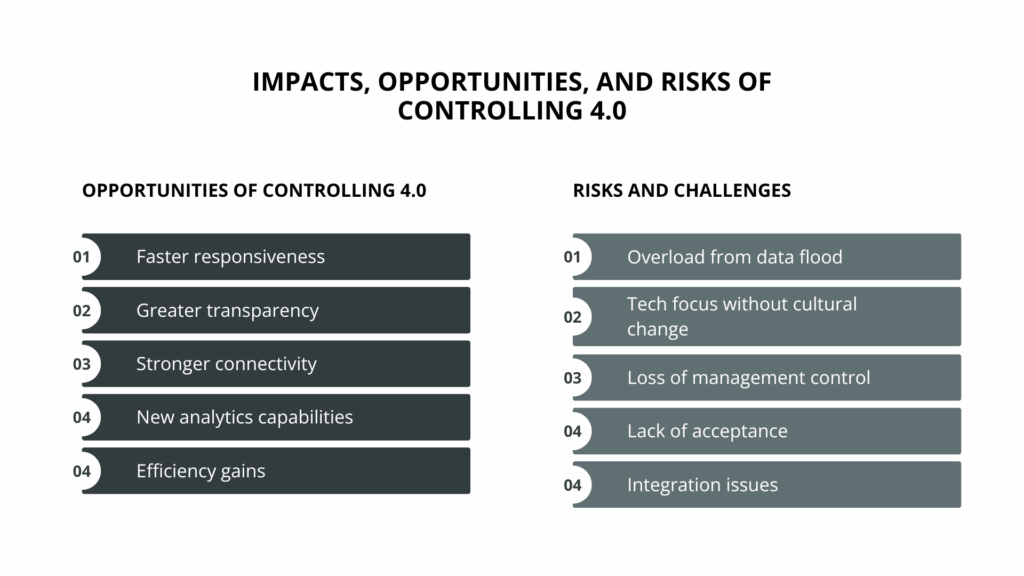
The most important facts in brief
Controlling 4.0 describes the profound transformation of controlling in the digital age. Driven by developments such as big data, artificial intelligence, business analytics and the increasing availability of data, it is not only the technological landscape that is changing, but also the role of the controller. They are moving away from simply preparing figures to becoming an active business partner to management – with a much stronger focus on analysis, forecasting and strategic corporate management.
The focus is on new requirements for systems, skills and processes: Modern controlling tools must be networked, flexible and data-driven. At the same time, the transformation requires close cooperation between controlling, IT and management. The integration of digital technologies not only brings efficiency, but also new challenges in dealing with data volumes, complexity and securing relevant management information.
Controlling 4.0 is therefore more than just a technological trend – it is a cultural, organizational and strategic upheaval that will have a significant impact on the future viability of companies.
Why Controlling 4.0 is indispensable today
Controlling is at the beginning of a fundamental transformation. Driven by digitalization, the increase in available data and the requirements for agile, forward-looking corporate management, the job profile of the controller is changing profoundly. Traditional tasks such as planning, controlling and reporting are no longer sufficient to actively shape complex, dynamic markets.
At the same time, the environment is evolving rapidly: Industry 4.0, new business models, global crises, volatile supply chains – they all increase the demands on decision-making quality, speed and transparency. This development makes it clear that if you want to continue to use controlling strategically in the future, you need more than just spreadsheets and rear-view mirror perspectives. Controlling 4.0 is needed – a new way of thinking, new systems and new skills.
This is not just about technological innovation. It is also about cultural change, changing processes and a new role within the company. The controller of the future is not just a supplier of figures, but an active business partner who prepares data-based decisions, helps shape strategy and supports change.
Vereinbaren Sie mit uns einen kostenfreien Beratungstermin.
Beratungstermin vereinbarenWhat is Controlling 4.0?
Concept, delimitation and significance for companies
Controlling 4.0 represents the next step in the development of controlling – a combination of technological innovation, changed task profiles and a new self-image within corporate management. While traditional controlling was often retrospective and KPI-oriented, Controlling 4.0 focuses on proactively shaping strategic decisions.
A key feature is the shift from being a pure information provider to actively shaping future viability. The controller becomes a mediator between the flood of data and management, between operational reality and strategic planning.
The importance of this change lies not only in increasing efficiency or improving forecasting capabilities. Rather, it is about redefining the role of controlling as a central driver of transformation in companies – with greater involvement in innovation, strategy development and digital processes.
The associated changes concern:
- the understanding of the tasks,
- the necessary skills,
- the systems and technologies used
- and responsibility in management work.
What used to be understood as “strategic controlling” is now developing into an integral part of digital business models, networked value chains and data-based corporate management under the label “strategic controlling 4.0”.
Drivers of development – digitalization, data & AI
Data availability and new technologies in controlling
The dynamics of Controlling 4.0 would hardly be conceivable without technological developments. In particular, it is rapid digitalization, the triumph of data-based processes and technological progress in the field of artificial intelligence (AI) that are driving the change. For controllers, this means that information is now available to an unprecedented extent, in real time and from a wide variety of sources – from ERP and CRM systems to IoT data from production.
The availability of data has changed fundamentally. Whereas monthly reports and static planning used to dominate, modern markets demand agile management, continuous analysis and data-driven recommendations for action. The challenge no longer lies in collecting data, but in handling the flood of data in a targeted manner: filtering, consolidating, interpreting and making it usable for decisions.
At the same time, the technological foundations of controlling are evolving. Modern BI systems, automated reporting solutions and analytics tools not only enable more in-depth data analysis, but also more precise forecasts and simulation-based scenarios. AI-supported algorithms are increasingly taking over routine activities – from budget monitoring to risk assessment.
Studies show: Companies that integrate AI and business analytics into their controlling processes achieve up to 33% faster decision cycles.
Changing roles – from controller to business partner
The new role of the controller in the digital age
With the advent of digital technologies, complex data landscapes and intelligent systems, the understanding of the role of controlling is changing fundamentally. The traditional guardian of figures is becoming an active driving force for decisions. The requirements are growing – not only technically, but also methodically, communicatively and strategically.
This development becomes particularly clear when comparing the classic controller with the modern profile of the Controlling 4.0 Business Partner:
| Aspect | Classic controlling | Controlling 4.0 |
|---|---|---|
| Focus | Past-oriented analysis | Predictive control & simulation |
| Role | Information supplier | Strategic business partner |
| Skills | Numeracy, Excel | Data analysis, BI, communication, process thinking |
| Tools | Reporting tools, tables | Business intelligence, AI, analytics platforms |
| Cooperation | Monthly exchange with management | Agile, interdisciplinary dialog in real time |
Effects, opportunities and risks of Controlling 4.0
More than technology: What Controlling 4.0 really changes
The introduction of Controlling 4.0 is not just a technological change – it changes mindsets, processes and structures. Companies that actively shape this change not only gain efficiency, but also create a reliable basis for strategic decisions in an increasingly data-driven environment.
Studies show: Companies with digitally transformed controlling processes react up to 50% faster to market changes than the industry average.
Opportunities of Controlling 4.0
- Faster response times thanks to real-time data
- Greater transparency of operational and strategic management information
- Stronger networking of departments and systems
- New analysis possibilities through AI and advanced analytics
- Efficiency gains through automation and data-driven planning
Risks and challenges
- Overloaded by a flood of data without clear structures
- Technology focus without cultural change
- Loss of control competence if systems are not used correctly
- Lack of acceptance among employees without training and involvement
- Integration problems with existing system landscapes

Why digital change needs strategically oriented controlling
Controlling 4.0 is not a sure-fire success. The transition to data-driven, technologically networked controlling requires clear objectives, a methodical approach and organizational connectivity. It is not enough to introduce modern tools or design dashboards – the full benefits can only be realized when technologies are intelligently integrated into existing processes and combined with a clear control logic.
At the same time, a culture is needed that understands data as a resource and sees control not as looking back but as shaping the future. This is where strategic controlling comes into play: it ensures that digitalization does not end in actionism, but instead makes a targeted contribution to achieving long-term corporate goals.
Those who actively shape this change – with responsibility, competence and entrepreneurial vision – not only make controlling more efficient, but also more powerful. What’s more, it becomes an instrument of corporate management that wants to – and can – survive in the digital age.
Frequently asked questions about Controlling 4.0
1 What is the central theme of Controlling 4.0?
Controlling 4.0 deals with the structural change in controlling in the digital age. It deals with new technologies, data-based management, changing role models and the integration of strategic tasks into corporate management.
2 What successes do companies achieve through the use of modern controlling approaches?
The targeted use of digital controlling tools demonstrably enables greater efficiency, better transparency and more informed decisions. Studies demonstrate success, particularly in the implementation of data-driven planning and control systems.
3. what economic impact does Controlling 4.0 have?
Controlling 4.0 strengthens the competitiveness of companies by leading to faster, more informed decisions. The integration of intelligent tools improves the ability to react to volatile markets and supports future-oriented economic management.
6 How can digitalization bring about cultural change in controlling?
Cultural change begins with transparency, communication and the active involvement of all stakeholders. It is not enough to introduce new tools – the handling of data, the role of the controller and cooperation with other areas must be rethought. Further training, pilot projects and clear objectives help to create acceptance.
7. does every company have to convert its controlling to 4.0?
Not necessarily to the full extent – but the development cannot be ignored. Even smaller companies benefit from targeted digitalization in controlling, for example through automated reports or business analytics. It is important to realistically assess your own potential and gradually implement what makes sense and is feasible.







